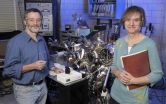Treatment trends for biceps injuries
For patients with tendinopathy both surgical and nonsurgical treatments show promise, need more study
2010-11-05
(Press-News.org) Synopsis: A patient with a long head biceps (LHB) tendinopathy, which is a pain and/or tearing of the tendon, may also have a shoulder problem and/or a rotator cuff tear. LHB tendinopahy can be caused by injury, trauma, overuse, inflammation or degeneration. Because of the variety of the causes and the range of possible severity, a patient needs a thorough examination, including radiographic imaging to determine the diagnosis and treatment. Traditional treatments include both surgical and nonsurgical approaches.
"The surgeon's goal in treating any long head biceps tendinopathy is to address the pain in a way that also respects the patient's lifestyle. And, as we found, there is a variety of excellent surgical and nonsurgical options. In developing this review, we also discovered the need for more comparative research data on surgical versus nonsurgical treatment outcomes for this condition." Said Shane Nho, MD, an orthopaedic surgeon who practices in Chicago and whose review appears in the November issue of the Journal of the American Academy of Orthopaedic Surgeons.
INFORMATION:
Statistics:
Recent studies reported no significant difference in function or patient satisfaction between the two primary surgical options, biceps tenotomy or tenodesis.
Each year, an average of 10 million people seek medical attention in a surgeon or physician's office or at the ER for a shoulder injury and an average of 4 million people come in with arm injuries.
Both surgical treatments for LHB tendinopathy are statistically successful, with a complication rate of less than 1 percent.
Trends noted:
Both surgical options -- biceps tenotomy and tenodesis (between which the article found no preference) now can be performed via arthroscopy.
The authors agree that nonsurgical treatment is the first – and in many cases may be the only –treatment necessary.
The authors of this review seem to agree that of the two surgical options, biceps tenodesis should be used in younger, active patients.
The first line of treatment for LHB tendinopathy is a variety of nonsurgical options, such as:
Rest;
anti-inflammatory drugs;
activity modification; and
physical therapy.
If those treatments do not offer the patient relief, a course of corticosteroid injections may be attempted. The authors do, however, report a concern about intratendinous (within the tendinous portion of the muscle) corticosteroid injections, which may predispose the patient to tendon rupture. More research is needed to address this concern.
Symptoms:
See your doctor or orthopaedic surgeon if you experience any of these symptoms.
Sudden, sharp pain in the upper arm
Audible popping or snapping in the shoulder or elbow
Cramping of the biceps muscle with strenuous use of the arm
Bruising from the middle of the upper arm down toward the elbow
Pain or tenderness at the shoulder and the elbow
Weakness in the shoulder and the elbow
Difficulty turning the palm of the hand up or down
Because a torn tendon can no longer keep the biceps muscle tight, a bulge in the upper arm above the elbow ("Popeye Muscle") may appear, with a dent (signifying absence of muscle) closer to the shoulder.
ELSE PRESS RELEASES FROM THIS DATE:
2010-11-05
Was it the evolution of the hand, or of the brain, that enabled prehistoric toolmakers to make the leap from striking off simple flakes of rock to fashioning a sophisticated hand axe?
A new study finds that the ability to plan complex tasks was key. The research, published Nov. 3 in the Public Library of Science journal PLoS ONE, is the first to use a cyber data glove to precisely measure the hand movements of stone tool making, and compare the results to brain activation. (Video: http://tinyurl.com/2w9cd4d)
"Making a hand axe appears to require higher-order cognition ...
2010-11-05
Shopping was the next most popular answer in the survey, carried out last month by researchers from Nottingham University Business School.
On a scale of zero to 10, Robin scored an average of 8.2 for visitors and 8.6 for locals in terms of the importance of his links to the city — and most agreed he was a "hero".
Yet tourism experts say neither Nottinghamshire nor Yorkshire, which stakes a rival claim to the legend, has made the most of Robin — despite fighting over his origins.
In fact, five years ago Nottingham infamously ditched him from its branding in favour ...
2010-11-05
According to a new study from the Journal of Bone and Joint Surgery (JBJS), patients with acute plantar fasciitis who perform manual plantar fasciitis stretching exercises, as opposed to shockwave therapy, had superior results and higher patient satisfaction.
Study details and findings:
A total of 102 patients who had acute plantar fasciitis pain, were randomly assigned to two groups. Acute is defined as any patient that experiences pain for less than six weeks. 54 people performed an eight-week stretching program, while 48 people received repetitive low-energy radial ...
2010-11-05
Vomiting is unpleasant. Nearly 30% of all patients suffer from nausea and vomiting after surgery. The financial repercussions of this are longer patient stays in the recovery room, with increased need for personnel. Appropriate prophylaxis and treatment can prevent postoperative nausea and vomiting. In a systematic review of the literature, Dirk Rüsch and co-authors investigate how treatment recommendations for nausea after general anesthesia can be improved (Dtsch Arztebl Int 2010; 107[42]: 733 741).
The pathogenesis of postoperative nausea remains unclear, but it has ...
2010-11-05
New York University researchers have developed a method to shape solid materials using a corn starch solution. The process, devised by researchers in NYU's Courant Institute of Mathematical Sciences and Department of Physics, offers a potential technique for material cutting and manufacturing processes.
Their work is described in the journal Physical Review Letters.
Manufacturers use a variety of methods for shaping solid materials, ranging from laser cutting to high-speed jets of water. While altering the shape of such materials, such as glass, metal, or stone, is ...
2010-11-05
BATON ROUGE – Genetic diseases impact millions around the world each and every day. Complex medical conditions with genetic predispositions, such as hypertension, can also weigh heavily on our lives. Susceptibility to hypertension has many genetic components and often goes undiagnosed until a person has signs of advanced disease.
Many imagine a day when science will give us the tools to discover how to work with these genetic issues and discover ways to not only diagnose, but to use them to our advantage as individuals. LSU Boyd Professor Mark Batzer and an international ...
2010-11-05
NASA's infrared satellite imagery has confirmed that Tomas is intensifying as convection is strengthening and cloud tops within the system are getting colder.
Infrared imagery helps scientists detect cold top temperatures within a tropical cyclone, and Tomas' cloud tops have grown colder over the last 24 hours. Tomas showed strong convective activity in his center as indicated by high thunderstorms that were as cold as -63 degrees Fahrenheit. The colder the cloud tops, the higher and stronger the thunderstorms are that power the tropical cyclone. The infrared imagery ...
2010-11-05
When it comes to public issues pertaining to science and technology, "talking it out" doesn't seem to work. A new study from North Carolina State University shows that the more people discuss the risks and benefits associated with scientific endeavors, the more entrenched they become in their viewpoint – and the less likely they are to see the merit of other viewpoints.
"This research highlights the difficulty facing state and federal policy leaders when it comes to high-profile science and technology issues, such as stem cell research or global warming," says Dr. Andrew ...
2010-11-05
A common roadside plant could have the right stuff to become a new source of biofuel, according to U.S. Department of Agriculture (USDA) studies.
Scientists with the Agricultural Research Service (ARS), USDA's principal intramural scientific research agency, have found that field pennycress yields impressive quantities of seeds whose oil could be used in biodiesel production.
Field pennycress belongs to the Brassicaceae family, along with canola, camelina and mustard—other prolific producers of oil-rich seeds. The ARS studies help support USDA's efforts to develop ...
2010-11-05
AMES, Iowa – Patricia Thiel of Iowa State University and the Ames Laboratory put a box of tissues to the right, a stack of coasters to the middle and a trinket box to the left.
"Nature," she said of her table-top illustration, "doesn't want lots of little things." So Thiel grabbed the smaller things and slid them into a single pile next to the bigger tissue box. "Nature wants one big thing all together, like this."
Thiel, an Iowa State Distinguished Professor of Chemistry and a faculty scientist for the U.S. Department of Energy's Ames Laboratory, and James Evans, an ...
LAST 30 PRESS RELEASES:
[Press-News.org] Treatment trends for biceps injuries
For patients with tendinopathy both surgical and nonsurgical treatments show promise, need more study

